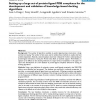173 search results - page 34 / 35 » Predicting the severity of a reported bug |
CNIS
2006
13 years 8 months ago
2006
Almost all current anti spam measures are reactive, filtering being the most common. But to react means always to be one step behind. Reaction requires to predict the next action ...
BMCBI
2006
13 years 7 months ago
2006
Background: Reverse-engineering regulatory networks is one of the central challenges for computational biology. Many techniques have been developed to accomplish this by utilizing...
BMCBI
2007
13 years 7 months ago
2007
Background: The number of algorithms available to predict ligand-protein interactions is large and ever-increasing. The number of test cases used to validate these methods is usua...
BMCBI
2004
13 years 7 months ago
2004
Background: Multiple sequence alignment algorithms are very important tools in molecular biology today. Accurate alignment of proteins is central to several areas such as homology...
BMCBI
2004
13 years 7 months ago
2004
Background: In a previous paper, we introduced MUSCLE, a new program for creating multiple alignments of protein sequences, giving a brief summary of the algorithm and showing MUS...

